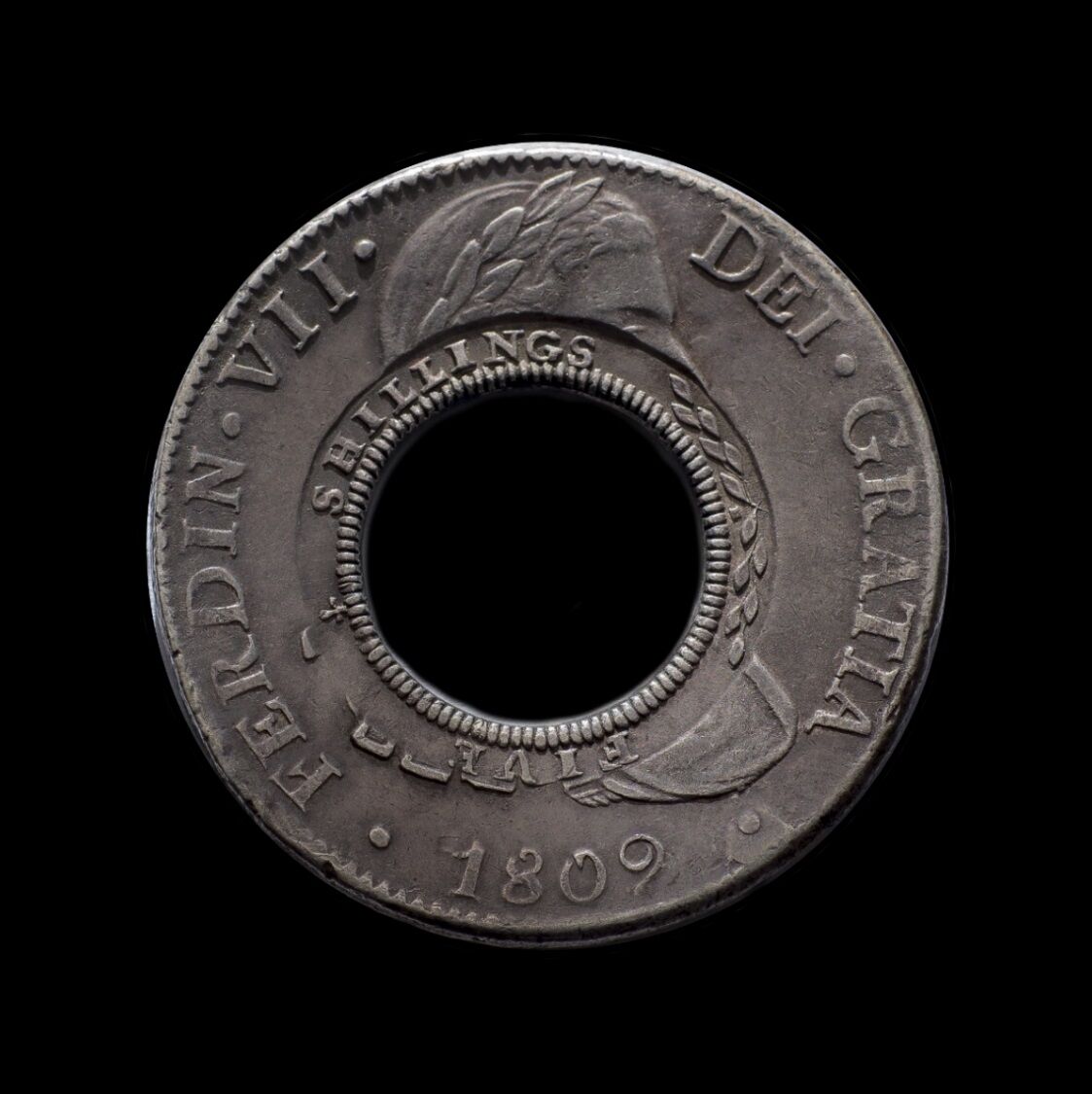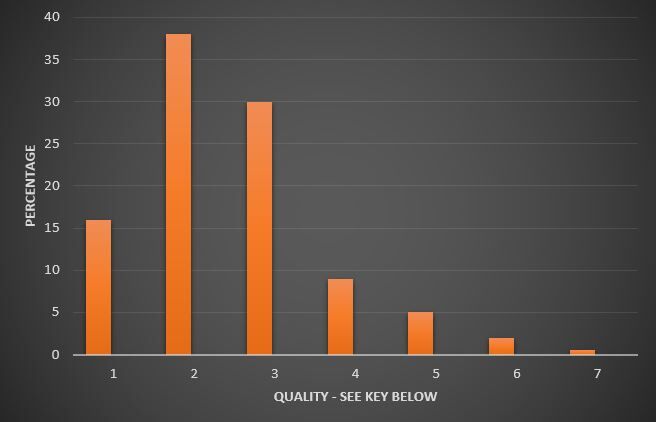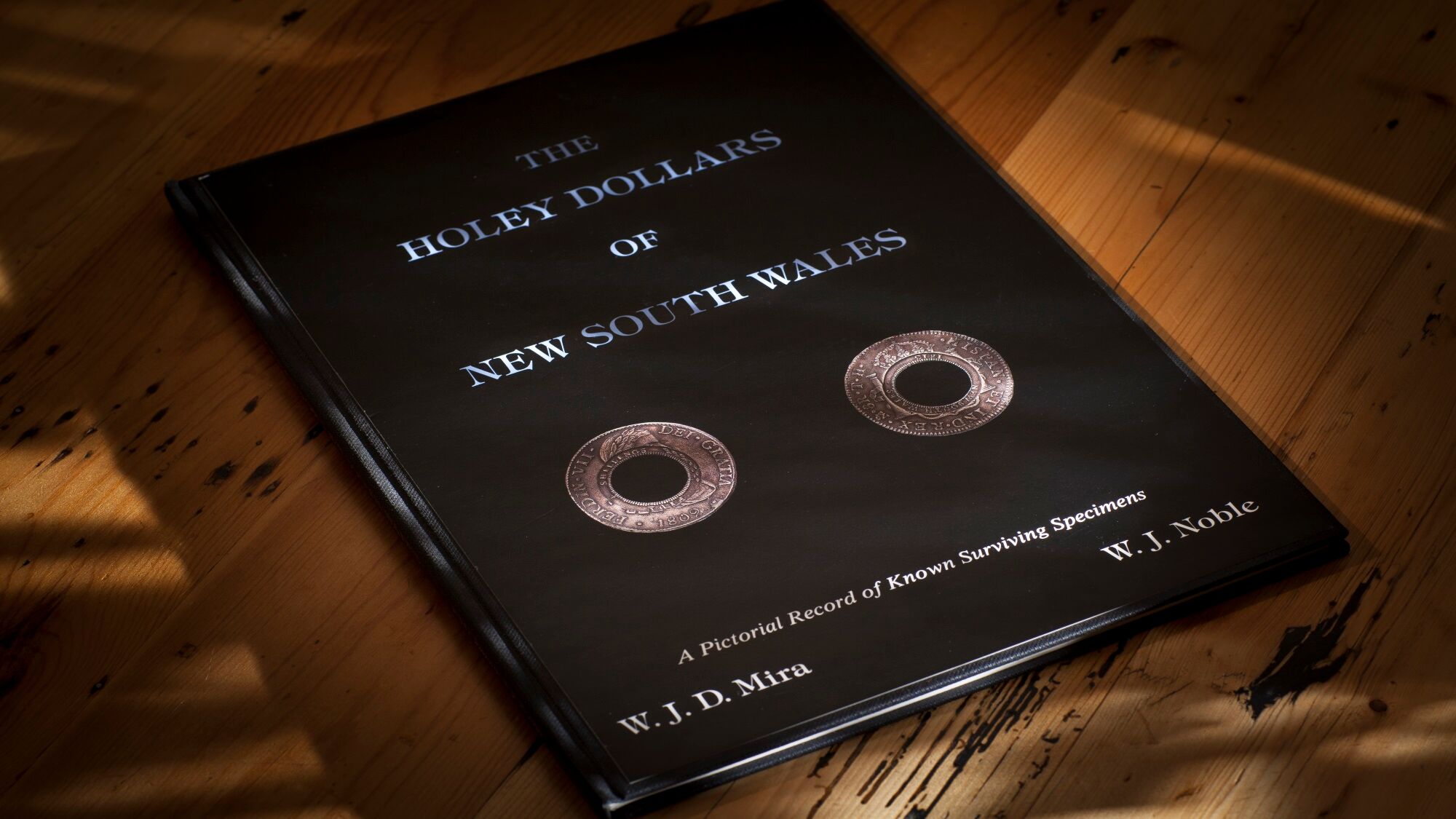Ferdinand VII, Mexico Mint, 1809 Spanish Silver Dollar.

Notice the detail in the hair and the robes. Also note the strength of the edges and the date 1798. This Holey Dollar is nicely toned and has original silver lustre.

The counter stamps are a supreme quality Good Extremely Fine on both obverse and reverse and also have original silver lustre.
The fundamental of this Holey Dollar.
When William Henshall created this Holey Dollar, he grabbed a Spanish Silver Dollar that had been struck at the Mexico Mint in the year 1809 and that depicted the legend and portrait of Ferdinand VII of Spain.
Using crude equipment, he cut a hole in it.
Henshall then continued the minting process by over-stamping the inner circular edge of the hole with the words New South Wales, the date 1813 and the value of five shillings.
That’s the point at which the holed silver dollar became the 1813 New South Wales Five Shillings, better known as the 1813 Holey Dollar.
A Holey Dollar of profound rarity.
Governor Lachlan Macquarie’s order for 40,000 Spanish Silver Dollars was not date specific. Any date would do. Any monarch would suffice. King Charles III, Charles IIII, Ferdinand VI or Ferdinand VII. Nor did he care where the coin was minted. Mexico. Peru. Bolivia. Or Spain. And quality was inconsequential. All that mattered was that it was a Spanish Silver Dollar.
And it is the interplay of these attributes, quality, mint, monarch and date that define a Holey Dollar and leads us to say that while all Holey Dollars are rare, some are far rarer than others.
If William Henshall had conducted a detailed inventory of the 40,000 Spanish Silver Dollars imported by Governor Lachlan Macquarie, he would have registered that those dollars struck with the legend and portrait of Ferdinand VII formed a minor portion of the shipment and were extremely rare.
By default, therefore, Holey Dollars created from Ferdinand VII Spanish Silver Dollars also are extremely rare.
And that has been confirmed.
Only 20 of the 275 Holey Dollars recorded in 1988 bore the portrait and legend of Ferdinand VII.
Thirteen of the twenty are held by private collectors, including this coin. One was unattributed. The balance, a total of six, are held in public institutions.
A Holey Dollar of quality.
The original 1809 Spanish Silver Dollar from which this Holey Dollar was created is graded in the premium quality levels of Extremely Fine indicating that it underwent slight circulation before the hole was cut into it in 1813.
Given that the Spanish Silver Dollar was the world’s greatest trading coin its state of preservation is remarkable.
The extent of usage of the Holey Dollar after it was released into circulation is evidenced by the wear to the counter-stamps, the over-stamping around the inner circular edge … New South Wales, 1813 and Five Shillings.
The counter-stamps of this Holey Dollar are also graded in the premium quality levels of Extremely Fine, which indicates that as a Holey Dollar, the coin underwent minimal usage.
Created in 1813 by mint-master William Henshall, demonetised in 1829 and somehow avoided the melting pot with minimal usage in between.
That this coin has survived in this state is again, simply remarkable.
The chart attached clearly shows the spread of Holey Dollars based on quality. And the relative ready availability of low quality examples. The chart also confirms the extreme rarity of high quality specimens.

***example chart - check with B
A Holey Dollar of standing.
This is the very first time that we have handled this Holey Dollar.
We have admired the coin from afar never knowing its whereabouts. And it is a fact that we have always wanted to handle it. Ferdinand VII Holey Dollars are extremely rare and the photograph on the cover of the Mira Noble Catalogue clearly shows that it is superb for quality.
We knew that the coin had been offered at the legendary Spink 1988 Auction, the property of revered Australian collector Paul Worth. And again, was shown on the front cover of the Auction Catalogue.
We also knew that it was sold by Barrie Winsor to a Sydney collector in the late 1980s. And that Winsor had lost contact with the client. And the coin.
The following collectors are noted as having owned this coin. Edward Wills, a Sydney collector active in the early to mid-1900s. Sir Marcus Clark O.B.E. Sydney dealer, S Lipscombe. Collector E. H. Wythes and revered collector Paul Worth.
The current owners acquired the coin from Barrie Winsor in the late 1980s where it has been held ever since.

© Copyright: Coinworks